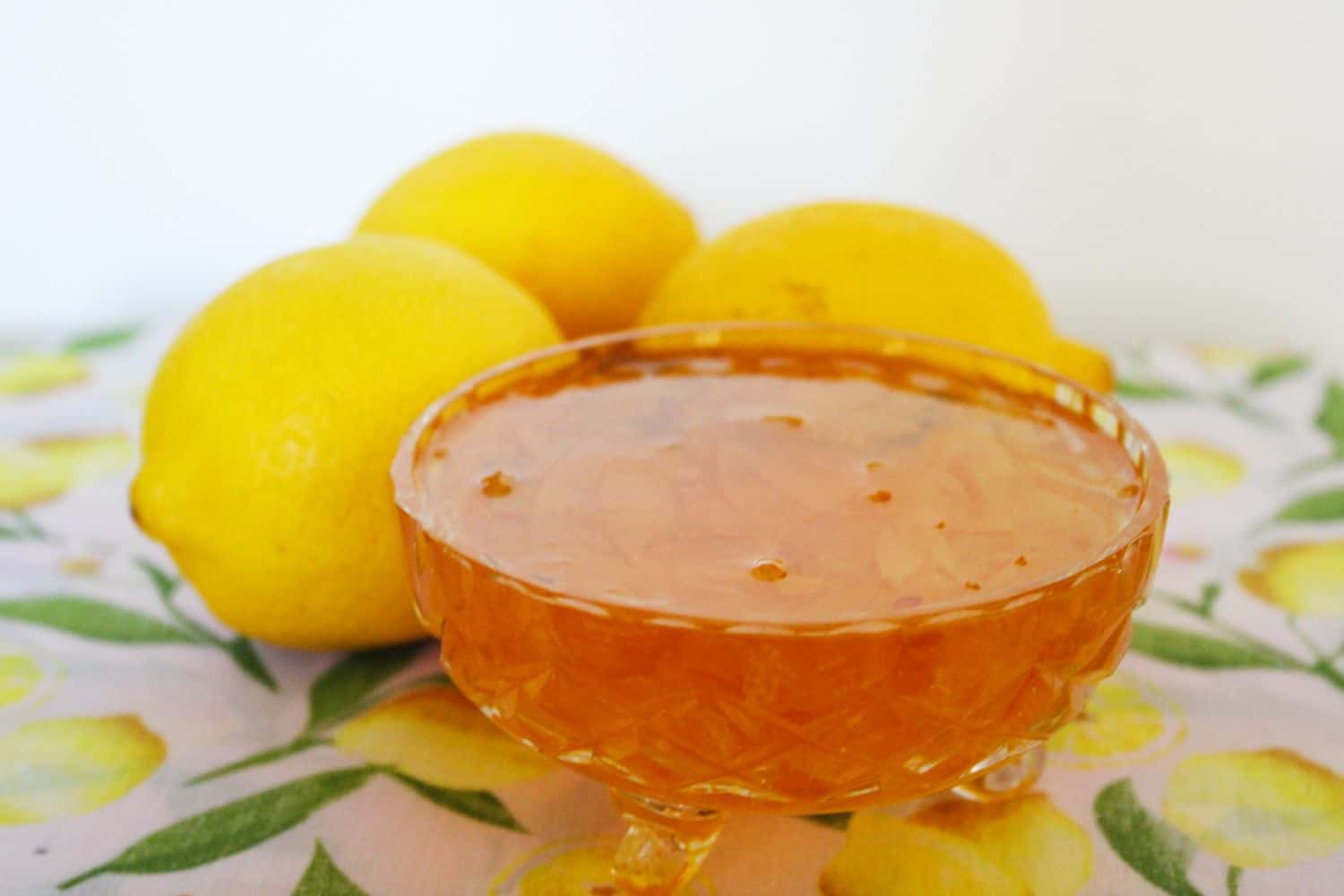
Lemon Marmalade has always been a favourite with my parents, my father in particular. He has been without his homemade breakfast condiment for a few weeks now and has politely let us know that a jar of shop-bought marmalade is not on his agenda.
As fortune would have it, a friend presented me with some beautiful, homegrown lemons and I have set to work. This is a classic method of making marmalade. It requires just three ingredients, and one of them is water. That is all that you need to make this fresh-flavoured condiment.
If you think that making marmalade is difficult, I want to assure you that it is easier than you may think. Although there is a great deal of science involved, it just requires that you follow a few simple steps.
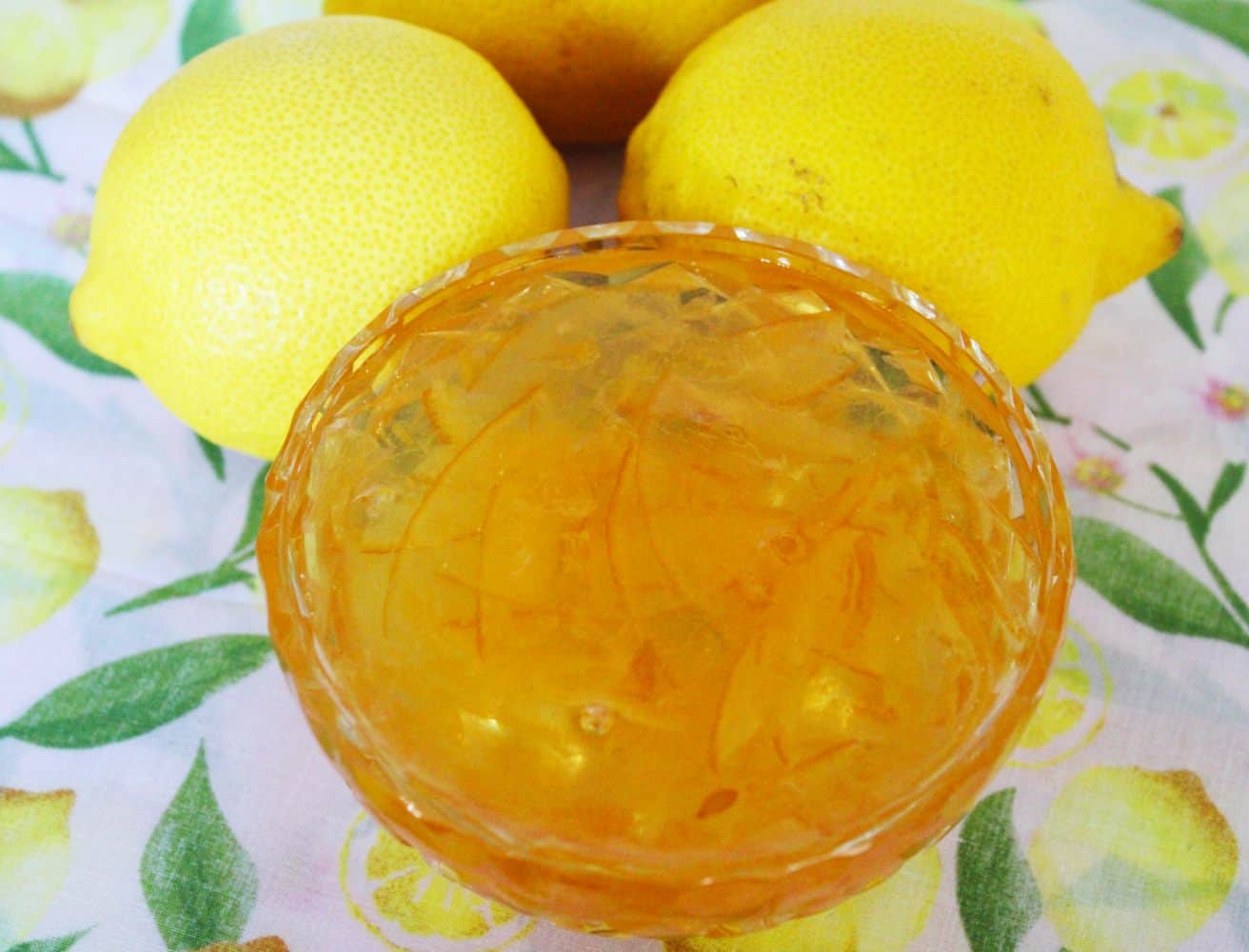
Let me tell you a little about Marmalade:
Marmalade is a favoured preserve on many breakfast tables. It's easy to appreciate that this zesty, tangy preserve is a great way to start the day.
Marmalade is only made from citrus fruits, unlike jam, which can be made from any variety of fruit. Moreover, citrus fruits are rich in naturally occurring pectin. High amounts of pectin and acid, such as in citrus, help the marmalade to set, making it ideal for preserving. As such, it is not necessary to buy special jam-setting sugar.
I regard homemade jams and spreads as luxury items. It's not that they are expensive to make, especially when the fruit is a gift, but there is an investment of time. However, having jars of marmalade that you have made yourself is tremendously satisfying.
The flavours are bright and clear and remember, there are just three ingredients. Compare that with the labels of some commercial varieties which often have a large range of additives.
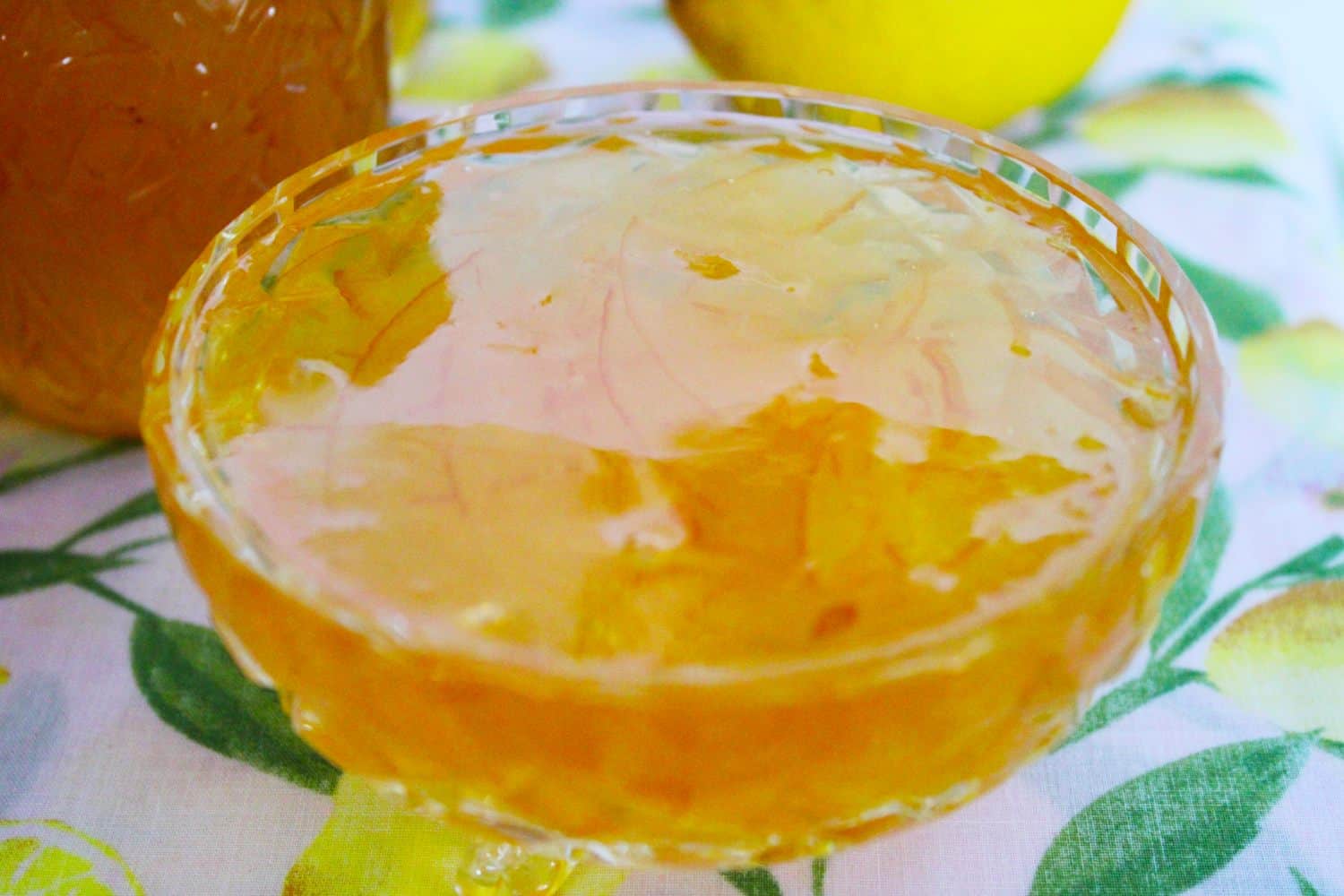
Ingredients in my Three Ingredient Lemon Marmalade:
Lemons:
Given that we will be using the entire fruit, it is preferable to use home-grown or organic lemons. Commercially produced lemons generally have a wax coating and may have been sprayed.
Sugar:
I use regular, granulated sugar. It is a large amount of sugar but it does much more than sweeten the marmalade. Its main function is to combine with the pectin and fruit acids to form a gel. In addition, it acts as a preservative that inhibits the growth of mould.
I don't recommend reducing the amount of sugar as it may interfere with the setting and preservation.
Water:
I have used filtered water but regular tap water is also fine.
How to make Three Ingredient Lemon Marmalade:
Making the marmalade is a two-day process. On the first day, you slice the lemons very finely and put them into a large bowl with water to soak overnight. Soaking the fruit serves two purposes.
Firstly, it softens the peel and secondly, it helps release the pectin required for setting the jam. On day two you cook the fruit and add the sugar.
When setting point is reached, as outlined in the recipe instructions, I remove the saucepan from the heat and set it aside for 10 minutes. This will help the fruit to settle and evenly distribute when poured into the jars.
Without settling, the fruit will rise to the top of the marmalade. And finally, ladle it into jars and smile with satisfaction at the result.
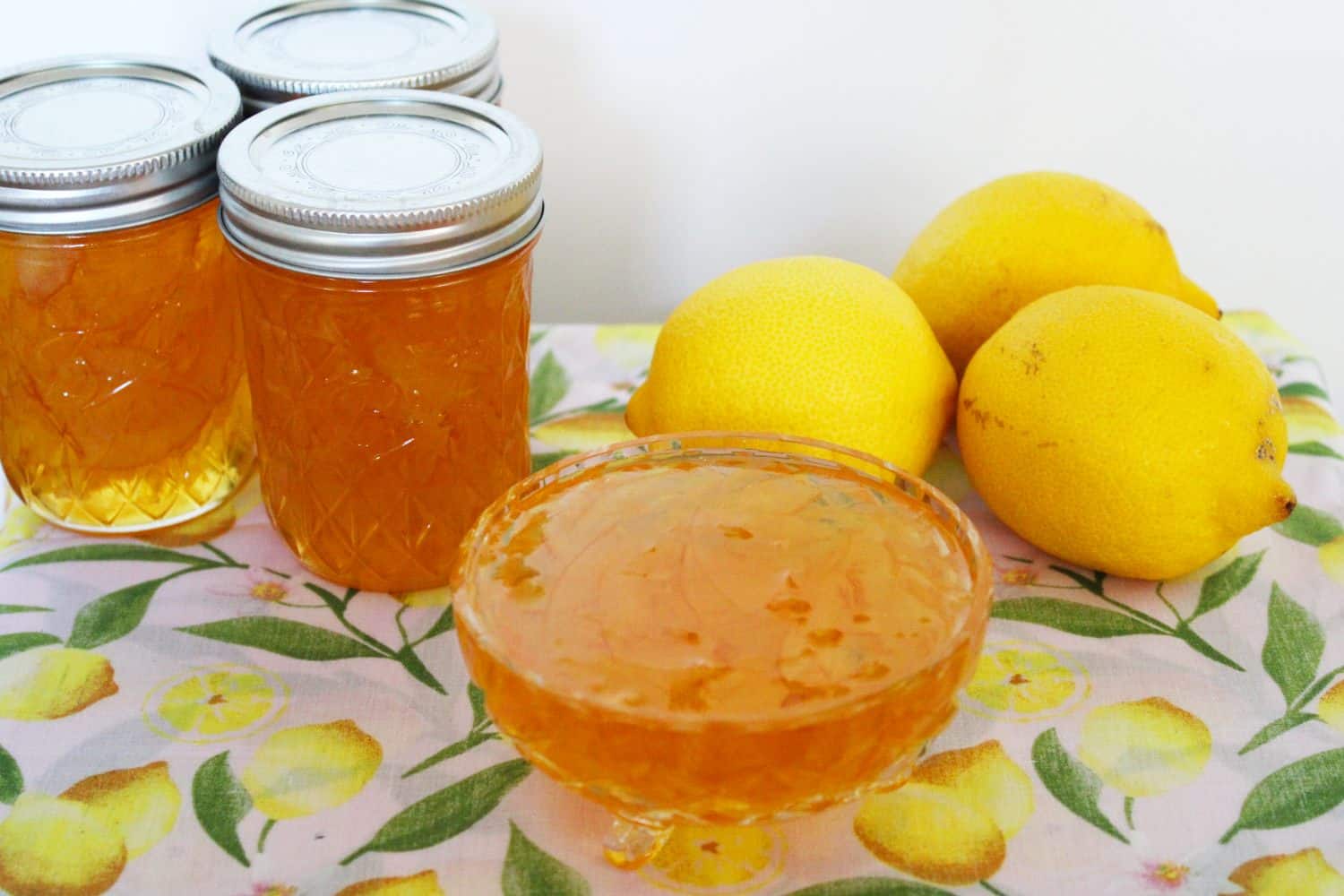
Tips for success:
You will not need any special equipment to make this recipe. However, a large saucepan is essential. When you add the sugar, it foams up enormously. Without a very large saucepan, there is the risk of it boiling over.
Your jars and their lids must be sterilised. I do this by heating them in the oven as outlined in the recipe.
As we are using the whole fruit, it is best to use organic or home-grown fruit. However, if you are only able to access commercially grown lemons, they need to be thoroughly cleaned.
Always use fruit which is in good condition and ideally some which are slightly under-ripe as they will contain more pectin. Bruised or damaged fruit may spoil the jam, causing it to deteriorate quickly.
It is important to cook the peel until it is tender before you add the sugar. Once you add the sugar the peel will no longer soften. After adding the sugar it is necessary to completely dissolve it before bringing the mixture back to the boil.
I find it best to check for setting point by checking a small amount of marmalade on a chilled plate. I use the "wrinkle" test, as detailed in the recipe. After reaching setting point, set the marmalade aside for 10 minutes to allow the fruit to settle.
Ladle the marmalade into hot jars to avoid the glass breaking.

Other uses for these ingredients:
We love lemons, and some of our other favourite ways to use them are:
- Individual Lemon Curd Meringues
- Classic Lemon Curd
- Gluten-Free Lemon Madeleines
- Belgian Lemon Tea Cake
- Quick and Easy Lemon Ice Cream
More delicious condiments and edible gift ideas:
- Apricot Jam
- Fresh Peach Chutney
- Easy Plum Jam
- Classic Lemon Curd
- Dill Pickled Cucumbers
- Sweet Chilli Sauce
- Balsamic Glaze
- Preserved Chillies in Oil

When it comes to using the Lemon Marmalade:
First and foremost, this bright and zesty condiment with the zingy flavour of lemon is a great wake-up call, perfect when slathered on your morning toast.
However, there are other ways in which to use it:
- A sticky glaze for chicken drumsticks;
- Make a sauce for pork tenderloin;
- Glaze a Christmas ham;
- Make crostini with goat cheese and prosciutto;
- Bake a lemon cake and make a glaze with the marmalade;
- Serve with Coconut Scones by A Baking Journey.
This refreshing condiment highlights the bright, tangy flavours of lemon. Although it is an ideal toast topping there are other ways in which to enjoy this condiment.
When you try it you will realise that there is no comparison between homemade marmalade and the commercially produced varieties.
Do let me know in the comments below when you have tried this delicious recipe.
Alex xx
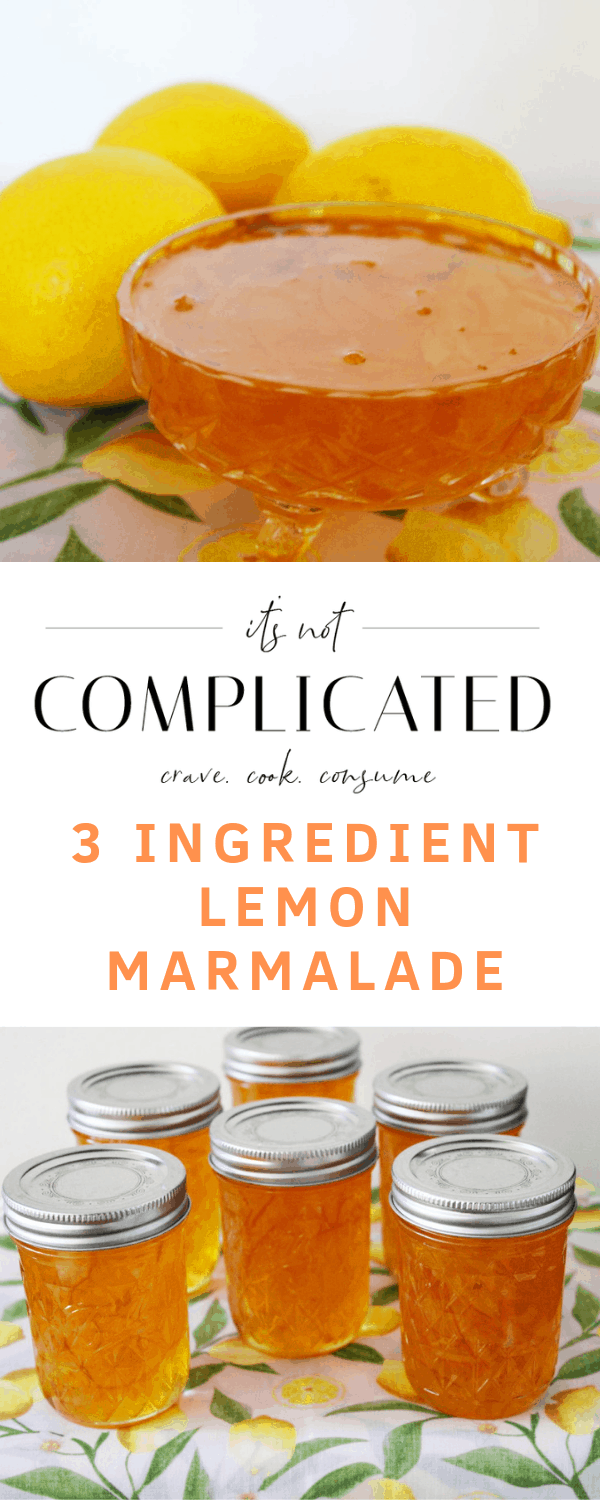
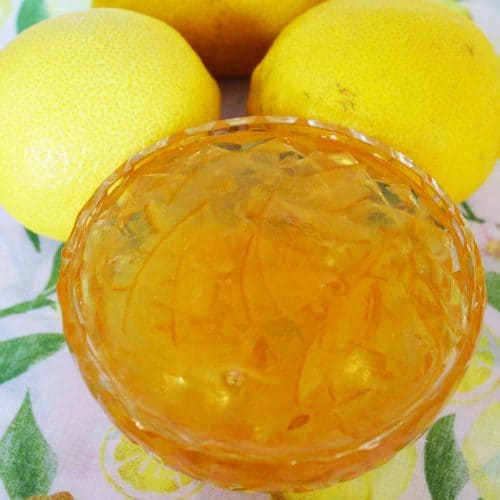
Three Ingredient Lemon Marmalade
Equipment
- 9 x 250ml Jars
Please note:
For accuracy, when weights are provided, we recommend weighing your ingredients. This will produce the best results. All oven temperatures listed are for fan forced.
Ingredients
- 500 g (17.5 ounces) lemons See Notes 1 & 2
- 6 cups (1.5 litre) water
- 8 cups (1.8kg) sugar
Instructions
Please Read First:
- Preserve making is quite simple, but we do recommend reading the recipe through first and following these tips:- weigh your ingredients for accuracy.- do not double the recipe or alter the quantities.- yes, it’s a lot of sugar. It’s also a lot of water. When making marmalade, the sugar is not just a sweetener, it also assists with gelling and preservation. When prepared properly, your end result will be the perfect mix of sweet, citrus tang and bitter, as marmalade should be. This is an old-fashioned recipe (my great great grandmothers.) - use a very large saucepan as the marmalade needs to rapidly boil and will foam up and you don’t want it to overflow.- ensure the marmalade reaches setting point. Keep in mind the marmalade will be very liquid while hot. Do not over boil as you will risk burning the marmalade.- allow 24-48 hours once jarred for the pectin to activate and the marmalade to set properly.- if after this time your marmalade hasn’t set, it likely wasn’t cooked for long enough initially. In this case, add the marmalade back to a clean saucepan with the juice of a fresh lemon. Bring back to the boil and start testing after 5 minutes of rapid boiling.
To sterilise the jars:
- Preheat the oven to 130 Degrees C (270F).Use glass jars with an airtight, metal lid. Wash them either in the dishwasher or by hand in hot soapy water, and rinse well. Check that the metal lids do not have rubber inserts. If they do, allow them to air dry.(See Note 9)
- Place upright jars and lids on a baking tray. Heat in the oven for at least 20 minutes, then remove and immediately fill with marmalade.
For the Lemon Marmalade:
- Place 2 saucers or small plates in the freezer, ready to check for the setting point of your marmalade.
- Thoroughly wash the lemons. Remove each end of the lemons and cut the lemons into quarters lengthways. Holding two of the quarters together, slice as thinly as possible and remove any seeds.
- Place the lemon slices in a non-reactive bowl. See Note 3. Add 6 cups of water, cover the bowl and leave the lemons to stand overnight.
- The following day, place the lemons and water into a large, non-reactive saucepan. - See Note 4.
- Over medium-high heat, bring the fruit and water to the boil. Boil for approximately 15 minutes or until the lemon peel is tender, stirring occasionally with a long-handled wooden spoon. - See Note 5. The time may vary slightly depending on the variety of lemon and the thickness of the slices.
- Add the sugar and stir well to dissolve it. After dissolving the sugar, return the fruit to the boil, stir occasionally and skim to remove any foam. Continue to stir until the marmalade reaches setting point, about 20 minutes. - See Note 6Remove from the heat to conduct the wrinkle test. If not set, continue to boil for another 1 minute and then test again.
- To test for setting point, I use the "wrinkle" test. Take one of your saucers from the freezer and pour a small amount of marmalade onto it. Let it cool for a minute then push against the marmalade with the tip of your finger. If the surface wrinkles it means setting point has been reached. Alternatively, if you are not confident checking this way or are not experienced at making marmalade, you can use the fail-safe method of using a jam/candy thermometer which you clip to the side of your saucepan. When attaching your thermometer, make sure that the base is not touching the bottom of the saucepan. Your marmalade has reached setting point when the temperature reaches 104.5 degree C or 220 degrees F. It will still be liquid at this point, and will set as it cools.
- Take the mixture off the heat and let the marmalade stand for about 10 minutes. This will help evenly distribute the fruit throughout the jars.
- Remove your jars from the oven and carefully ladle the marmalade into the heated, sterilised jars. You need to be very careful. Splashing yourself with hot marmalade will result in a very serious burn. I suggest you have clothing with long sleeves and ensure that you do not have children nearby. Put lids on jars immediately, and seal well - being careful to use a cloth or oven gloves to handle the jars/lids.
Video
Notes
- The weight of the lemons, before trimming the ends and removing the seeds, was 530 gm/1.2 lbs. We use Eureka or Lisbon lemons for this recipe.
- As the peel is such an important part of the marmalade, I like to use organic or home-grown lemons. Commercially produced lemons generally have a wax coating and may have been sprayed. If this is all that you can obtain, you can clean the lemons by placing them in a colander and pouring over freshly boiled water. Then, scrub them gently with a nail brush while holding them under cold running water.
- Non-reactive bowls and saucepans are stainless steel, glass, ceramic or enamelled cookware. Aluminium, copper and iron bowls or pans are reactive. Acidic foods, such as lemons, may discolour and take on a metallic taste if these are used.
- A large saucepan is essential. When you add the sugar, it foams up enormously. Without a very large saucepan, there is the risk of it boiling over.
- To stir, use a long-handled wooden spoon. Metal will become dangerously hot.
- Boiling time depends on several factors, the width of your saucepan and the heat at which the fruit is boiled.
- The Marmalade will be shelf stable for approximately 12 months.
- Your marmalade will be very liquid when you add it to the jars so please don't be concerned. It will continue to thicken as it cools. Leave it for 24-48 hours and then check again. If it is still runny, you can re-boil the marmalade. Empty the contents of the jars back into the saucepan and bring to a boil. To increase the pectin and help the marmalade to set, you can add the juice of half a lemon. Boil for a few minutes and test again.However, if the marmalade was initially boiled too long, it can still result in it not setting as the pectin may have been damaged.
- Properly sterilising your jars is an essential process to remove bacteria which could cause your preserves to spoil. I prefer to sterilise jars in the oven. To do this, preheat your oven to 130 Degrees C (270F). Use glass jars with an airtight, metal lid. If recycling jars, ensure that the jars do not have cracks or chips and the lids are in good condition. Discard any lids that are pitted or rusted. Wash the jars and lids either in the dishwasher or by hand in hot soapy water, and rinse well. Do not dry them with a tea towel. Place upright jars and lids on a baking tray. If you are using kilner jars with rubber seals, be sure to remove the seals before placing the jars in the oven. The dry heat of the oven would damage the seals. Boil the seals separately in a saucepan for about 10 minutes. Heat the jars in the oven for at least 20 minutes. When your preserves are ready to bottle, use thick oven mits or jar tongs to remove the jars. Do not place them on a cold surface as they may shatter. I place mine on a wooden chopping board which I cover with a tea towel. Always sterilise a few more jars than you think you will need. It is better to have too many jars than not enough.
- Please note, the nutritional information is based on one 250ml jar. Please take this into account, as you most likely won't be consuming a whole jar in one sitting. The nutritional information is an estimate only.
Nutrition Estimate:
Nutritional Disclaimer:
The nutritional information is an estimate only, and is derived from online calculators. For accurate results, we recommend calculating the nutritional information based on the ingredients and brands you use.

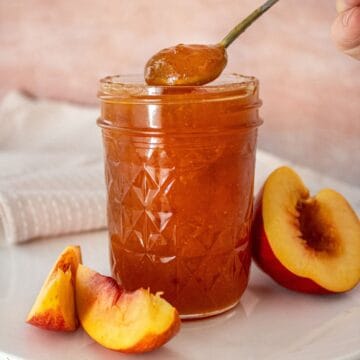
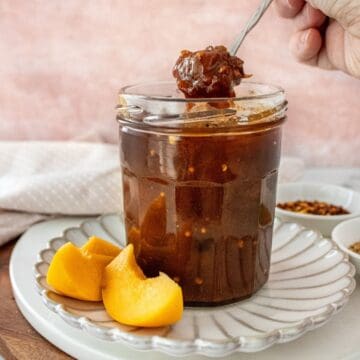

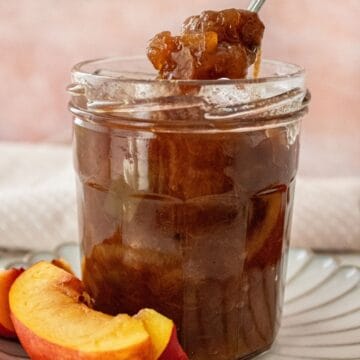
Jann says
I have Meyer lemons. Will this recipe work with them as they are less tart and acidic as other lemons.
Alexandra Cook says
Hi Jann,
It sure will 🙂
My Great Aunt used to always exclusively use Meyer lemons from her tree. Keep an eye on the cooking time - it may take a couple of minutes less as the skins are less thick than some varieties, but otherwise you can follow the recipe as written 🙂
Thanks! Alex
Jann says
Thank you for your prompt reply. Today’s the day!
Alexandra Cook says
Happy marmalade making, Jann!
Reach out if you have any queries 🙂
Julia says
hi, sorry I did disobey your rules in some areas and ended up with great, tangy marmalade. I had more fruit that needed using and ended up with about 3.5kg of prepared fruit. I used 6 cups of water and 3kg of sugar as didnt want it to be too sweet! I washed and sterilised jars as directed and 6months later I have no mould. I am not an experienced jam maker so wasn't sure about wrinkle test, so I added a small amount of pectin just before removing from heat. I am very happy with results, it set well, it has kept well, its lovely and tangy, not too sweet! thanks
Alexandra Cook says
So happy it worked out well for you, Julia 🙂
Alex xo
Richard Patterson says
My mother, who died in August five years ago at age 99.5, always said that she only ever made marmalade if the month had a U in it!
She died in August and made her last large batch two weeks before she died. I am still enjoying it.
It’s now the 28th August so I had best get started!!
Alexandra Cook says
Hello Richard,
Your mother had the same thoughts as my great grandmother 🙂
How special you are still enjoying the last batch she made.
Alex xo
Angela Vuong says
Hello is it possible to halve the ingredients and make 4.5 jars instead?
Thanks
Alexandra Cook says
Hello Angela,
That should work fine 🙂
Just keep an eye on the cooking time - it will likely take a few minutes less.
Alex xo
Robin says
Delicious and delightful!
Alexandra Cook says
Thank you, Robin!
Alex xo
Lucy says
Where did the video go?
Alexandra Cook says
Hi Lucy,
I am still able to see the video from my end, so not quite sure why you can't! It is located in the recipe card.
If you scroll to the top of the page, you'll find a "jump to video" button which will take you directly there.
Let me know how you get on 🙂 Alex xo
Lucy says
Below is all I can find of the video, not a clickable link. The JUMP TO VIDEO just puts me into the text.
into the heated, sterilised jars. You need to be very careful. Splashing yourself with hot marmalade will result in a very serious burn. I suggest you have clothing with long sleeves and ensure that you do not have children nearby. Put lids on jars immediately, and seal well – being careful to use a cloth or oven gloves to handle the jars/lids.
Video
Notes
The weight of the lemons, before trimming the ends and removing the seeds, was 530 gm/1.2 lbs. We use Eureka or Lisbon lemons for this recipe.
As the peel is such an important part of the marmalade, I like to use organic or home-grown lemons. Commercially produced lemons generally
Alexandra Cook says
Hi Lucy
I am sorry you still haven’t been able to get it to work! Unfortunately, I can’t replicate the issue - the video is playing for me on both mobile phone and computer, and I have checked on both Safari and Chrome browsers. I have also asked a few family members to check and they are able to watch the video too.
I reached out to my tech team and they asked if you had any ad blockers installed? This could apparently stop the video from playing.
Also, they suggested clearing your cache and trying a new browser.
One other thing too - if you go to say the Grapefruit Marmalade post (linked), are you able to see the video for that? I am just curious if you are able to see any videos, or if it is just the one not working.
Thanks, Alex
Mitch says
I have the same problem trying to view the video!
Alexandra Cook says
Hi Mitch,
I am sorry you are also having issues. My team has tried to replicate this, and hasn't been able to.
I was hoping you'd be able to share what browsers and device you have tried on, and if you have any ad blockers installed? My ad network provides the coding for my videos, and they have said the video player is fine, but that it is possible an ad blocker will stop the videos from showing.
If you'd prefer to email me, please feel free.
Also curious if you are able to view other videos on the website, such as the Grapefruit Marmalade?
We'd be grateful for any information you can provide so we can try and troubleshoot why you might be experiencing an issue.
Thanks, Alex
Pam Breese says
Made this delicious jam today. We have bottled the jam into tiny jars as wedding favours. They look beautiful. Thank you so much.
Alexandra Cook says
Hi Pam,
What a lovely idea 🙂 Thank you so much for sharing!
Alex xo
David says
Great recipe, just finished making a batch. Can’t wait to try
Alexandra Cook says
Thank you, David!
Enjoy 🙂 Alex xo
June says
fabulous to make I'm just waiting for the marmalade to set .. fingers crossed..will update..
could I use limes instead of lemons for my next batch please thank you june
Alexandra Cook says
Thank you, June! 🙂
Reach out if you have any issues.
I am hoping to publish my lime recipe in a couple of weeks - it does require a slightly different technique and quantities, so isn't a direct swap as such. Alex xo
Lucy says
I was about to ask the same thing!! We love your lemon recipe, but our lime tree is calling out for a lime version 🙂 Will keep an eye out for the recipe. Luce x
Annie says
Hi Alex
Thank you for sharing your grandmother's lemon jam recipe, which turned out perfectly for me. I am so happy with the results, and it is absolutely delicious. I was wondering if you've ever added crystalized ginger to this recipe, and if so, how much and when would be the best time yo add during the process.
Thank you again. Fantastic! 🙂❤️🍋
Alexandra Cook says
Hello Annie,
Thank you so much - this is lovely to hear!
I personally haven't added crystalised ginger to this recipe, but this is something my Aunt does! She adds about 150g-200g of finely chopped to the mixture after the sugar has been dissolved.
Alternatively, I have made it many times with freshly grated ginger - I add between 1/4 cup to 1/2 cup, depending on how vibrant I want the flavour to be. I add this when I start to boil the mixture.
Let me know how you get on 🙂 Lemon and ginger is such a delicious combination. Alex xo
Sherry Miller says
Do you do a water bath (canning) after you pour into jars? If not, what is the shelf life if not sealed?
Alexandra Cook says
Hello Sherry,
Thank you for reaching out 🙂
For the jars, I follow the method that my great grandma used – the hot sterilised jars and the hot marmalade with the lids put on immediately cause a vacuum to form a seal as they cool. As the marmalade has just been vigorously boiled, we don’t boil it again in a water bath. The jars are shelf-stable for 12 months, and only need to be refrigerated once they have been open.
This is a method most commonly used in Australia/UK, although I am aware that in the USA/Canada water bath canning is the more popular method.
If you prefer to water bath, you certainly can, and you can find more information here.
Please feel free to reach out with any questions and I hope you'll enjoy making the marmalade 🙂
Alex
Ursula says
I've just finished my Lemon marmalade and your recipe turned out successfully and tastes fantastic. thanks for sharing. I'm sure my family will enjoy having this scrumptious marmalade on toast. I'll give a shot at your other recipes. best regards Ursula
Alexandra Cook says
Thank you so much, Ursula!
I am so happy you had great success with this recipe, and I hope you'll find many more to try on the blog.
Please reach out any time! Alex xo
Lucy says
Planning to make this recipe as soon as I buy the lemons. I'm wondering if it is OK to water bath the finished marmalade for long term storage or shipping?
Alexandra Cook says
Hi Lucy!
Thanks for the question.
I haven't personally water bathed this recipe, but know that several readers have over the years. 🙂
Alex xo
Maria says
Perfect every single time! I have soaked the lemons as per the recipe sometimes and also added an extra day to the soak when I run out of time. No matter what, it always comes out great. I invested in a very big pot and no spills or stove mess to clean up - we go through a jar a week easily.
Alexandra Cook says
Hi Maria,
Thank you so much for your comment.
A big pot does make all the difference, doesn't it? 🙂
So happy that this is a recipe you come back to.
Alex xo
Alison Borgas says
I made this recipe, but had to re-boil as it hadn't set properly. I have a question about the colour. Initially after the first boil, the colour was still clear and golden, like lemons. Once I re-boiled it, it became darker orange like in your photos. Is colour an indicator of whether it's been cooked enough, in your experience?
Alexandra Cook says
Hi Alison,
Thank you for the question!
The colour can certainly be an indicator, and it will darken the more it is cooked - if it is very dark and overcooked, the sugars have over caramelised etc. However, it is not an indicator that I would rely on solely.
My preferred method is the cold plate test, but I do also use a thermometer to give me a good idea of how things are tracking too.
I have found that no two batches of marmalade will necessarily look the same - this can be as simple as type of lemon, how much pith they have etc.
Alex xo
Sharon G says
This recipe makes a lovely, delicious marmalade, which sets up perfectly. I live in Southern California and have a large old lemon tree which gave a bumper crop this year. So I have been giving away bags of lemons, making lemonade by the bucket and have put up two jars of Moroccan picked lemons.
I'll probably freeze some as well.
I wanted to try lemon marmalade and found your recipe on the internet. I have made mixed citrus marmalades before, which I love. But this time I needed a pure lemon recipe and most I found on the internet called for Meyer Lemons which are a hybrid and sweeter than my lemons. I hesitated to try one of those with my much stronger lemons thinking it might not set up correctly.
Your recipe was the answer. I filled 8 one US cup jars and am starting on a second batch. The marmalade on my ladle is setting up nicely and tastes wonderful. The fruit in the jars is well distributed. Although the taste is sweeter than other marmalades I have made, I love knowing that this is an authentic recipe which generations have used. I can't wait to have marmalade on buttered toast tomorrow morning.
Alexandra Cook says
Hello Sharon,
Thank you so much for taking the time to leave your lovely comment 🙂
That lemon tree of yours sounds incredible!!
You will find that the sweetness can mellow over the coming days as the flavours really come together. I hope you'll enjoy your breakfast tomorrow very much 🙂
Alex xo
Ruth says
It didn't gel for me. I tried boiling it to 225 F, I tried adding the juice of another lemon, and in the end I added pectin. So I got the texture, finally, but not really the flavor I was hoping for. I wonder if the flavor could be improved by removing some of the bitterness. I used to make candied grapefruit peel and it involved boiling the rind and discarding the water. Maybe I just didn't have the best lemons--I decided to look for a lemon marmalade recipe because lemons were cheap at the market!
Alexandra Cook says
Hello Ruth,
Thank you for your comment.
As you mentioned, it could be to do with the lemons. If they were older or not the best quality, they would have had a lower level of pectin which causes issues with setting.
I am wondering also, when you tried the juice of another lemon and the pectin, had you let the marmalade cool for 24-48 hours in between? It can take this amount of time to set properly, and will still be very runny when hot. If not, I'd recommend this next time, as I have never needed to add pectin to any of my marmalade or jam recipes to get them to set.
Marmalade should be slightly bitter, but if it is overly so, again this could be due to the type of lemons. The pith is essential for this recipe, being rich in pectin, but with good quality lemons, this recipe will yield a balance of sweet, bitter and citrus tang.
Please reach out with any questions 🙂 Alex xo
Winona says
Fantastic recipe. Enjoying some on toast with my coffee now. Thanks!
Alexandra Cook says
Thank you, Winona!
Alex xo
Dave says
My go to recipe! Thank you.
Alexandra Cook says
Love it, Dave!
Thank you, Alex xo
Judy Morris says
I'm looking forward to trying your recipe. I have always used apple peels with low pectin fruit jams and for those made from liquid (like high amounts of lemon juice) also grated tart apple for added pectin amounts. I take the peels out before jarring the jams and eat the candied peels.
Alexandra Cook says
Hello Judy,
I hope you'll enjoy it, and I am so curious to give it a try with the apple myself! While I have added apple to jam over the years, I have not done it with marmalade. I can imagine it would be lovely with the lemon.
Alex xo